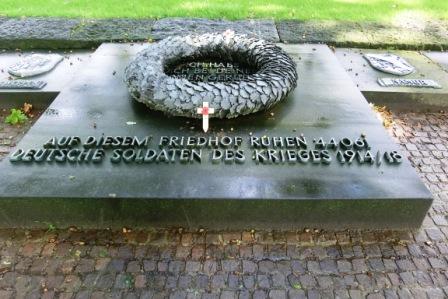November 24, 2017. After the stirring Last Post Ceremony at the Menin Gate Memorial the evening before, we continued our war memorial tour of the Flanders area. Our first stop was Sanctuary Wood Cemetery in Zillebeke, near the Sanctuary Wood Memorial we had previously visited. This is where Charles Benjamin Murray BUXTON died and is likely buried in this cemetery in an unknown grave.

Maple trees line the road to Sanctuary Wood Cemetery in Zillebeke. (Photo credit: Daria Valkenburg)
Previous blog entries gave details about Buxton’s life and career. (See Who Can Put A Face To Charles Benjamin Murray Buxton? and A Daytime Visit To Menin Gate Memorial in Ypres and The Princess Patricia’s Light Infantry Memorial and A Visit To Sanctuary Wood)

Charles Benjamin Murray Buxton. (Photo courtesy of John Marchbank family collection)
While serving in the No. 2 company of the Princess Patricia Canadian Light Infantry (PPCLI) during the Battle of Mount Sorrel on June 2, 1916, he was wounded and reported missing. When no sign of him was found by June 4, 1916, he was declared as being killed in action.
The war diary of the unit for June 2, 1916 explains what happened on that day:
“General Action: Mount Sorrel. Enemy attacked soon after 1 pm after four hours of intensive bombardment on PPCLI and 8th Brigade front. On the Regiment’s right the garrison (No. 1) was annihilated and ‘the Loop’ overrun, but the support line held in Warrington Avenue and Gourock Road (No. 3), Lovers Walk and Maple Copse (No. 4). On the left No. 2 held the Appendix and beat off a bombing attack, ultimately withdrawing at night. The crisis had passed by 5 pm, but the bombardment continued through the night.”
In the book ‘With The Patricia’s In Flanders 1914-1918 Then & Now’ by Stephen K. Newman, it was noted that “Initially No. 2 Company in the left front position was on the periphery of the destruction. Much of this was due to the closeness of the trenches in the Appendix and the German shells over ranging by twenty yards. Only the right hand platoon bore the brunt of the fire.”
A personal account quoted in the book goes on to say that as of 2:30 am on June 3, No. 2 Company withdrew from their front line trench…. “We could get no word from Headquarters and with no sign of reinforcements, the young Lieutenant who had crawled all the way on his hands and knees to relieve our wounded Captain decided we better retire. By this time we had piled up about 20 more casualties, some severely wounded and these had to be carried out if they were to have a chance to live. There were about 45 of us left untouched in the company and as almost all the wounded had at least to be supported, if we took them out, there would not be enough left to hold the trench, so it was decided to leave.”

Map of area, showing where Buxton and Campbell lost their lives. (Map courtesy of John Stephens, author of ‘Travel Tips for Canadians: Visiting The Great War Sites of Flanders and Vimy Ridge’)
It’s not known at what point during that terrible day that Buxton was hit, but from the accounts it seems clear that in the chaos his body was never initially recovered, and anything that might have identified went missing. With no known grave to pay tribute to, we found four unknown graves from the Canadian Regiment to put Canadian flags on, and on one we also placed a PEI flag in memory of Charles Buxton.

Pieter placed flags by an unknown grave of the Canadian Regiment in Sanctuary Wood Cemetery. (Photo credit: Daria Valkenburg)
After fortifying ourselves with a warm drink at the Hill 62 Sanctuary Wood Restaurant, where Pieter inspected a British cannon, we decided to continue on to Maple Copse Cemetery, where George Albert CAMPBELL lost his life.

Pieter by a WW1 era British cannon outside the Hill 62 Sanctuary Wood restaurant and museum. (Photo credit: Daria Valkenburg)
Comments or stories? You can share them by emailing us at dariadv@yahoo.ca or by commenting on this blog.
© Daria Valkenburg
































